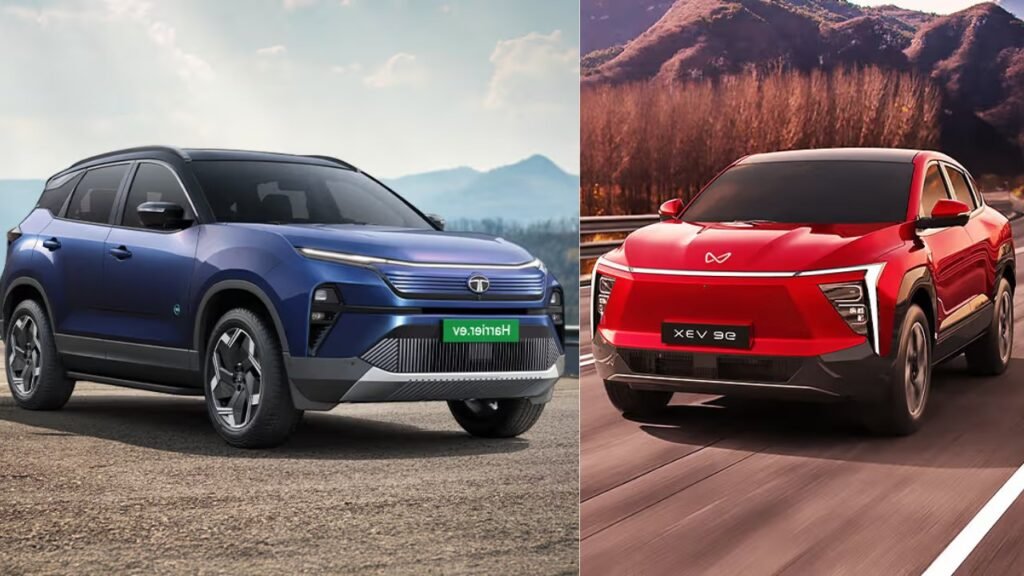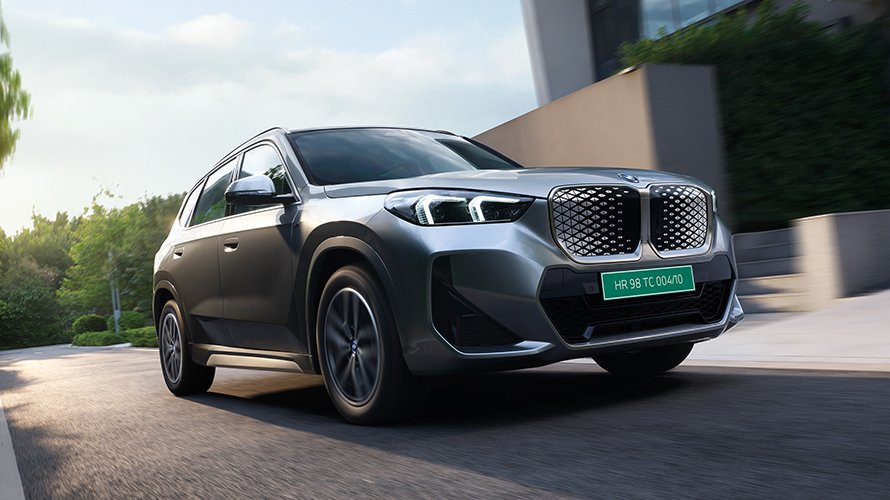In the rapidly evolving Indian electric vehicle (EV) market, two flagship SUVs are vying for attention in the D-segment: Tata’s Harrier EV and Mahindra’s XEV 9e. While Tata’s Harrier EV stands out as the only model in its lineup with all-wheel-drive (AWD) capability—available in higher variants—Mahindra’s XEV 9e and its sibling BE 6 remain rear-wheel-drive (RWD) focused for now, though the brand’s internal combustion engine (ICE) SUVs like the XUV700 do offer AWD. For this comparison, we’re zeroing in on the entry-level variants: the Tata Harrier EV Adventure S (with a 65 kWh battery) and the Mahindra XEV 9e Pack One (with a 59 kWh battery). Priced closely around ₹22 lakh (ex-showroom), these models target budget-conscious buyers seeking premium EV features without breaking the bank.
This analysis is split into two key sections: upfront value (size, design, performance, and features) and cost of ownership (on-road price, maintenance, and running costs over five years and 50,000 km). We’ll crown a winner based on both factors, drawing from real-world data and expert insights. Both vehicles have earned five-star Bharat NCAP ratings and come with lifetime battery warranties for the first owner (15 years unlimited km, transferable to 10 years/2 lakh km for subsequent owners). Let’s dive in.
The Harrier EV Adventure S and XEV 9e Pack One are both spacious D-segment EVs, but they differ in dimensions, styling, and tech. The XEV 9e edges out in length and wheelbase, offering a more futuristic coupe-SUV silhouette, while the Harrier EV provides a taller, wider stance reminiscent of its popular ICE counterpart. Here’s a breakdown:
Dimensions and Design
- Length, Width, Height, Wheelbase, Ground Clearance, Boot Space: The XEV 9e measures 4,789 mm in length (182 mm longer than the Harrier EV’s 4,607 mm), with a 2,775 mm wheelbase (34 mm longer). It’s slightly shorter in height (1,626 mm vs. 1,672 mm) but offers superior boot space at 663 liters (plus a 150-liter frunk) compared to the Harrier EV’s 502 liters (67-liter frunk in RWD). Ground clearance is nearly identical (200 mm vs. 198 mm), but the XEV 9e’s longer wheelbase translates to better rear legroom and a more “unconventional” design that turns heads—earning it a perceived value edge of ₹31,000 in V3 Cars’ analysis for its attention-grabbing aesthetics.
- Wheels: The XEV 9e rides on 19-inch steel wheels (upgradable to 20-inch alloys higher up), while the Harrier EV gets 18-inch alloys standard, adding a premium touch.
The XEV 9e’s coupe-like profile feels modern and bold, ideal for urban trendsetters. The Harrier EV, however, looks familiar and robust, appealing to those who prefer a traditional SUV presence. On perceived value from size alone, the XEV 9e pulls ahead slightly due to its extra boot space and length.Performance and EfficiencyBoth variants deliver similar claimed ranges despite battery differences, highlighting the XEV 9e’s edge in efficiency (it’s lighter at around 2,100 kg vs. Harrier EV’s 2,200+ kg).
| Aspect | Tata Harrier EV Adventure S (65 kWh) | Mahindra XEV 9e Pack One (59 kWh) |
|---|---|---|
| Battery Capacity | 65 kWh (LFP) | 59 kWh (LFP) |
| Claimed Range (ARAI/MIDC) | 538 km | 542 km |
| Real-World Range | 420-455 km | 400-450 km (city/highway mix) |
| Power | 238 PS / 315 Nm (RWD) | 231 PS / 380 Nm (RWD) |
| Power-to-Weight Ratio | ~108 PS/ton | ~110 PS/ton |
| Torque-to-Weight Ratio | ~143 Nm/ton | ~181 Nm/ton (39 Nm/ton higher) |
| 0-100 km/h | ~7.5 seconds | ~6.8 seconds |
The XEV 9e’s higher torque (380 Nm) provides punchier low-end acceleration, making it feel more responsive in city traffic. The Harrier EV’s larger battery offers a slight range buffer for longer trips, but the XEV 9e is more efficient overall—translating to a perceived powertrain value advantage of ₹41,000 per V3 Cars’ tool. Neither base variant has AWD (Harrier EV reserves it for the 75 kWh Empowered trim at ₹28.99 lakh), but both include drive modes (Eco, City, Sport for Harrier; Range, Everyday, Race for XEV 9e) and regen paddles.FeaturesBoth pack a punch in safety and convenience, but the Harrier EV Adventure S edges out with more premium touches. Common features include six airbags (side/curtain included), ESC, LED headlamps/DRLs, hill hold/descent assist, day/night IRVM, rear disc brakes, parking camera/sensors, traction control, driver drowsiness detection, 12.3-inch touchscreen with wireless Android Auto/Apple CarPlay, connected car tech, auto AC with rear vents, all power windows, 60:40 split rear seats with armrests, auto headlamps/wipers, cruise control, paddle shifters, tilt/telescopic steering, and height-adjustable driver seat.Harrier EV Unique Features (Perceived Value: ₹2.40 Lakh):
- Rear wiper/washer
- TPMS (Tyre Pressure Monitoring System)
- Keyless entry with push-button start
- Multi-drive/terrain modes (Normal, Wet/Rain, Rough Road)
- Electrically adjustable/foldable ORVMs with auto-fold and puddle lamps
- 18-inch alloy wheels
- Roof rails
- Leather upholstery
- Soft-touch dashboard
- Panoramic sunroof
XEV 9e Unique Features (Perceived Value: ₹89,000):
- Rear defogger
- 150L frunk
- Reclining rear seats
- Triple 12.3-inch screens (driver display, infotainment, passenger screen)
- Wireless charging
- Snow mode
- Boost mode for instant power surge
The Harrier EV’s sunroof, leather seats, and alloys make it feel more luxurious upfront, giving it a ₹1.5 lakh+ perceived feature advantage. Overall, despite the XEV 9e’s size and torque edges, the Harrier EV delivers ₹79,000 more upfront value based on V3 Cars’ comprehensive tool.
For a five-year/50,000 km ownership period, we factor in Delhi on-road prices (including RTO, insurance, and fastag) and assume public charging at ₹25/unit. Both benefit from low EV maintenance, but the Harrier EV’s larger battery slightly impacts running costs.
- On-Road Price (Delhi): Harrier EV Adventure S ~₹24.50 lakh; XEV 9e Pack One ~₹24.41 lakh (₹9,500 difference favoring XEV 9e).
- Periodic Maintenance (5 Years/50,000 km): EVs have minimal costs (no oil changes). XEV 9e: ~₹9,500 less than Harrier EV due to simpler RWD setup (total Harrier ~₹25,000; XEV ~₹15,500).
- Running Costs (50,000 km): Based on claimed efficiency (Harrier ~12.5 km/kWh; XEV ~9.2 km/kWh but lighter/more efficient in practice), XEV 9e saves ~₹15,000 on electricity (total running: Harrier ~₹1.00 lakh; XEV ~₹0.85 lakh).
Total Ownership Cost Difference: Harrier EV costs ~₹34,000 more over five years. However, its ₹79,000 higher perceived value (from features and build) offsets this, netting a ₹45,000 advantage for the Harrier EV.Service networks for both Tata and Mahindra are nationwide, with Tata offering 3 years/1.25 lakh km vehicle warranty (no km cap for Mahindra) and 8 years/1.6 lakh km motor warranty (Mahindra: 8 years unlimited km). Battery warranties are lifetime for both first owners.
The Tata Harrier EV Adventure S emerges as the clear winner, offering superior upfront value through its premium features, larger battery, and robust build—outweighing the XEV 9e Pack One’s slight edges in size, torque, and efficiency. While the Mahindra saves marginally on ownership costs, the Harrier’s net ₹45,000 value lead makes it the more sensible buy for most. If you prioritize futuristic design and boot space, go for the XEV 9e; for luxury and versatility, the Harrier EV is unbeatable.



